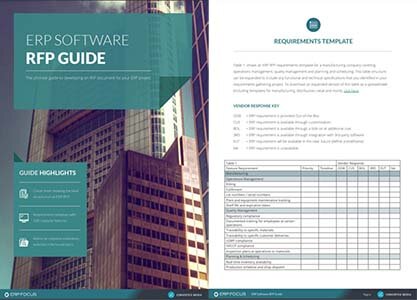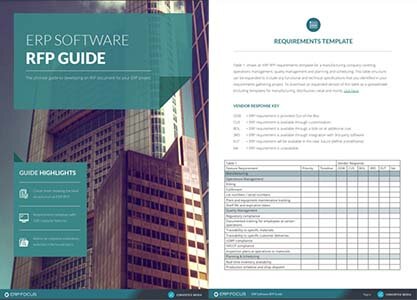ERP reporting: 5 features to consider for your system
PDFs and spreadsheets are what usually comes to mind when discussing the subject of ERP reporting features. Think of a sales backlog or a stock status report. These reports might be packaged with out-of-the-box versions of ERP. They can often can be filtered and manipulated at a basic level by the ERP user and are often used as a basis to build reports more specific to the company’s needs. But what advanced reporting features should you keep an eye out for when searching for ERP?
1. Reports outside of business intelligence modules
These might not be the first things in mind with ERP reports. A check is a report; it is printed and shows a record of what is to be paid to someone. A purchase order is a report showing the agreement to buy something and pay for it after receipt. The label that prints automatically when that PO is received is also a report. It shows the part number in text and barcode as well as the description of the part.
Recommended reading: ERP software RFP guide - learn how an RFP document can communicate your reporting requirements to vendors
The point here is that many ERP features which aren’t necessarily lumped into an “ERP reporting” module should still be considered from a reporting standpoint. Make sure your ERP caters for your reporting needs at its core.
2. Pivot tables and user queries
Spreadsheets might be the most common and frequently used kind of ERP data export. Most of these exports are conducted because a user is searching for a trend or hidden gem somewhere within the ERP data. One might take a standard report and print it to a file. Then that report is opened with a spreadsheet and the columns are parsed. This is a system workaround, plain and simple.
Allow ERP users to query data within the system and you will see a sharp upturn in system use and buy-in.
Why not eliminate this workaround by implementing ERP which supports database pivot tables? Allow ERP users to query data within the system and you will see a sharp upturn in system use and buy-in.
3. Financial compliance
Balance sheets, income statements, and cash flow statements are another category of reports often considered essential in most ERP systems. The format might be prescribed by local accounting principles but the data is similar worldwide. Often a business will have multiple versions of these. There could be a public version of the annual report and another internal version designed to focus action. Context should be the driving factor when selecting an ERP for financial reporting.
4. Ad hoc and agile report generation
The needs of any organization evolve over time as new threats and opportunities arise. Ad hoc reports are one tool used by most businesses to ensure agility in their systems. Many of today’s ERP systems have a query or report generator tool. That query can extract data filtered to meet the needs of the report. Data from several internal tables can be combined to present information to be used to support a decision to be made immediately. The query might be refined further and be the basis of a new standard report or the need will be resolved and the report never runs again.
5. Dashboards with user access controls
Many reports are designed to show up on a computer screen and never be printed. A dashboard that shows key performance indicators to the CEO is an example. ERP dashboards should be able to combine quantitative and qualitative data on a per user, per department, or per role basis. If these user access configurations are absent from your current dashboard setup, it might be time to consider your options.
Free white paper

ERP Software RFP Guide & Template
The comprehensive guide to developing an RFP document for your ERP project

Related articles
-

Three misconceptions about ERP metrics
Which ERP metrics should you measure, and how can you use them to tell whether a system is succes...
-

Secret KPI: Why Your ERP Implementation Team Matters More Than Software
Learn how Godlan ensures successful ERP implementation for manufacturers with proven strategies &...
-

Three reports your warehouse managers should have on their ERP dashboard
Ensure your warehouse managers are as well-informed as possible with these three key warehouse ER...

